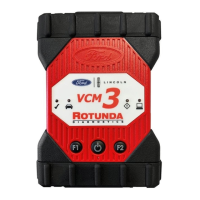1 699 200 890
2020-03-06
| Ford Motor Company
User instructions | VCM3 | 5 en
Important information on WLAN and
Bluetooth
WLAN (Wireless Local Area Network) is the
term used to describe a wireless local network.
Bluetooth and WLAN provide a radio link on
thefree2.4GHzISMband(ISM:Industrial,
Scientific, Medical). This frequency range is
subject to state legislation, can however be
used without a license in most countries.
Consequently a large number of applications
and devices employ this frequency band for
transmission. This can result in frequency
interference and faults.
Depending on ambient conditions, the radio
link may deteriorate, e.g. in the case of
Bluetooth links, cordless telephones, radio-
controlled thermometers, radio-controlled
garage door openers, radio-controlled light
switches or radio-controlled alarm systems.
i Bluetooth can cause bandwidth collapse
in the WLAN network. The antennas of
Bluetooth and WLAN devices should be at
least30centimetersapart.UsetheUSB
extension cable (special accessory) to
maintain a distance between the Bluetooth
USB adapter on the computer and the WLAN
antenna.
i Extreme caution is to be taken if wearing
pacemakers or other vital electronic
devices when using wireless systems, as
proper functioning of these items could be
impaired.
Pay attention to the following to ensure the
best possible connection:
a The radio signal always tries to find the most
direct path. When setting up the computer
and access point, make sure there are as few
obstacles as possible (e.g. steel doors and
concrete walls) which could interfere with
the signal from and to the VCM3.
a Inside buildings, the range of the WLAN /
Bluetooth is also greatly influenced by the
construction materials used. Conventional
masonry, wooden walls and various types
of dry construction wall scarcely impair
the propagation of radio waves. Thin
gypsum walls are however problematic,
as considerable amounts of moisture may
accumulate in the gypsum and result in the
absorption of radio signals. Metal walls and
concrete (in particular reinforced concrete)
largely block out radio waves. Cellar ceilings
are often impenetrable. Generally speaking,
walls with a lot of installed metal (e.g.
pipes, cables) obstruct radio waves.
a Radio reception is also impeded by large
metal objects such as radiators and
window frames as well as active sources
of interference such as radio telephones,
motion detectors and microwave ovens.
a Human beings are also an obstacle to
wireless transmission. It must therefore
always be ensured that no-one stands
between the transmitter and receiver.
a We advise having the network infrastructure
installed and maintained by a network
specialist.
a When using a WLAN connection, keep the
SSID and the codes for the wireless link in a
safe place. Make sure these data are readily
to hand in case faults occur.
a When commissioning, we recommend that
you tour the site thoroughly: Determine
where in your building VCM3 functions and
where the limits for wireless transmission are
located.
a The wireless link is affected by weather
conditions. The reception signal may
therefore vary.
a Please contact your network specialist for
any queries.
a In the event of problems with the radio
link, the USB link can be activated and used
instead of the radio connection.

